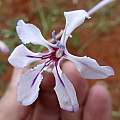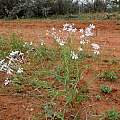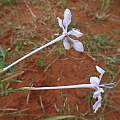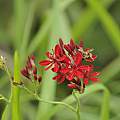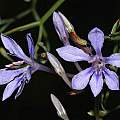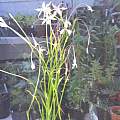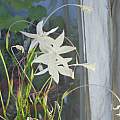Afrosolen is a genus in the Iridaceae family proposed by Goldblatt and Manning in December 2016 to replace the name Psilosiphon that was offered by Goldblatt and Manning in 2015 when Lapeirousia was broken into 4 genera. Lapeirousia with 27 species was retained and the other two new genera described were Schizorhiza with one species from the Southwestern Cape, South Africa and Codonorhiza with 7 species from the Southwestern Cape, South Africa. Psilosiphon Entwisle for a genus of algae had predated the publication of the proposed name by Goldblatt and Manning and thus this new name for a genus in the Iridaceae family was offered. The generic name reflects the tubular perianth of this widespread African genus (Greek solen = pipe). This genus has 15 species, all from summer rainfall tropical and eastern southern Africa. Corms are bells shaped, flat, pale or dark brown, with fibrous tunics, usually becoming loosely fibrous with age. Stems of most species have a branching pattern. Leaves are plain with a visible and sometimes prominent main vein. The inflorescence is a false panicle. Afrosolen at this update in December 2018 does not seem to be reflected in the online databases which are still listing these species under Lapeirousia. Codonorhiza and Schizorhiza are recognized however so information about Afrosolen from the above references is provided below as it may be recognized at a later date.
Afrosolen abyssinicus (R.Br. ex A.Rich.) Goldblatt & J.C.Manning, syn. Geissorhiza abyssinica R.Br. ex A.Rich., syn. Lapeirousia abyssinica(R.Br. ex A.Rich.) Baker, syn. Psilosiphon abyssinicus (R.Br. ex A.Rich.) Goldblatt & J.C.Manning is restricted to the Ethiopian highlands. Height: to about 35 cm.
Afrosolen avasmontanus (Dinter) Goldblatt & J.C.Manning, syn. Lapeirousia avasmontana, syn. Psilosiphon avasmontanus (Dinter) Goldblatt & J.C.Manning, is endemic to Namibia where it grows on open stony sloping ground. Growing 20 to 30 cm, this species has radially symmetrical pale blue to light purple flowers with white heart shaped markings outlined with darker purple, a short tube and dark brown to blackish corm tunics that decay into vertical strips. It flowers February to April.
Afrosolen bainesii (Baker) Goldblatt & J.C.Manning, syn. Lapeirousia bainesii Baker, syn. Psilosiphon bainesii (Baker) Goldblatt & J.C.Manning, is a species of the dry plains of central interior southern Africa. Growing from 30 to 60 cm, this species has bilaterally symmetrical, white to pale pink flowers, usually marked with a red to brown streak and pink to red markings at the base of the three lower tepals. The tube is pink to purple. The sweetly scented flowers open late in the afternoon and last through the night and into the next day withering with dry and warm daytime temperatures and are pollinated by hawk moths. Flowering is January to April, sometimes earlier. The corms tunics are composed of light brown densely compacted fibers and are edible and eaten raw or roasted by the indigenous population. Photos from iNaturalist taken by Christine Sydes in Botswana April 2016 and shared under a CC BY-NC license
Afrosolen coeruleus(Schinz) Goldblatt & Manning, syn. Lapeirousia coerulea Schinz, syn. Psilosiphon coeruleus (Schinz) Goldblatt & Manning, is native to seasonally wet habitats in summer rainfall Namibia into Botswana. Growing 15 to 30 cm, this species has radially symmetrical blue to light purple flowers with white speared shaped markings outlined with darker purple on each tepal. Corm tunics are light brown with the outer layers with fine reticulate fibers; the difference in corms, habitats, white markings, and smaller flowers distinguish it from Afrosolen avasmontanus. It flowers January to April.
Afrosolen erongoensis (Goldblatt & J.C.Manning) Goldblatt & Manning, syn. Psilosiphon erongoensis Goldblatt & J.C.Manning, is restricted to the Erongo Mountains in west central Namibia. It has bilaterally symmetrical violet flowers with the lower tepals with a white median mark near the base edged in darker violet. It flowers in February and March.
Afrosolen erythranthus (Klotzsch ex Klatt) Goldblatt & J.C.Manning, syn. Lapeirousia erythrantha (Klotzsch ex Klatt) Baker, syn. Psilosiphon erythranthus (Klotzsch ex Klatt) Goldblatt & J.C.Manning, has a wide distribution: eastern Botswana in Southern Africa and Tropical Africa (eastern Angola, southern Democratic Republic of the Congo, Zambia, Zimbabwe, Malawi, Tanzania, and central Mozambique). Growing from 20 to 45 cm high, plants are repeatedly branched with flowers crowded terminally in a false panicle. Flowers are bilaterally symmetrical, either blue-violet with spear-shaped white marks outlined in dark blue to purple on the lower tepals or crimson red, then without markings or lower tepals each with a white or dark red median streak. Flowering time is late January to March, occasionally from mid-December. Photo from iNaturalist taken by sethmusker December 2018 in Malawi and shared under a CC BY-NC license.
Afrosolen gracilis (Vaupel) Goldblatt & J.C.Manning, syn. Lapeirousia gracilis Vaupel, syn. Psilosiphon gracilis (Vaupel) Goldblatt & J.C.Manning, is restricted to Western Namibia where it mostly grows in rocky sites, but also on sandy flats. It has 2 to 6 flowers on the main lateral branches. Flowers are bilaterally symmetrical, long tubed, scented, pale blue to white with bluish marking on lower tepals. Growing from 10 to 30 cm high, it flowers at the end of summer, February and March, occasionally later. Photos can be found here.
Afrosolen masukuensis (Vaupel & Schltr.) Goldblatt & J.C.Manning, syn. Lapeirousia masukuensis Vaupel & Schltr., syn. Psilosiphon masukuensis (Vaupel & Schltr.) Goldblatt & J.C.Manning, is distributed in Mozambique, Malawi, Zimbabwe and lowland Limpopo and Mpumalanga, South Africa where it is found in relatively wet habitats (vleis, the edge of marshes, or in seasonally waterlogged flats). Plants grow from 40 to 60 cm with branches 5–9 flowered, often crowded distally with bracts overlapping. Flowers are long tubed, bilaterally symmetrical, dark blue to violet or greenish cream with purple to red and white spear-shaped median streaks in basal half of the lower tepals. Flowering time is February to April.
Afrosolen otaviensis (R.C.Foster) Goldblatt & J.C.Manning, syn. Lapeirousia otaviensis R.C.Foster, syn. Psilosiphon otaviensis (R.C.Foster), is restricted to rocky sites, mostly granite or shale in Namibia and Angola. Growing from 30 to 55 cm high, it has creamy white to cream, sometimes pale lilac long tubed (40 to 45 mm long) bilaterally symmetrical flowers with the lower tepals with purple median spear-shaped markings. The inflorescence is a rounded to flat-topped false panicle, repeatedly branched with the ultimate branches with up to 5 flowers. Flowering time is February to April.
Afrosolen rivularis (Wanntorp) Goldblatt & J.C.Manning, syn. Lapeirousia rivularis Wanntorp, syn. Psilosiphon rivularis(Wanntorp) Goldblatt & Manning, is primarily a plant of seasonally wet depressions on rock outcrops and seasonally waterlogged grassland distributed in the northern half of Namibia into adjacent Angola and perhaps Zambia. Growing from 10 to 30 cm high, it has bilaterally symmetrical pale blue flowers with white nectar guides on lower three tepals outlined in blue-violet; lower tepals often have tooth-like median ridges up to 1 mm long. Flowering of the Namibian population is late February to early April.
Afrosolen sandersonii (Baker) Goldblatt & J.C.Manning, syn. Lapeirousia sandersonii Baker, syn. Psilosiphon sandersonii (Baker) Goldblatt & J.C.Manning, is distributed in Botswana, Gauteng, Mpumalanga and the northwest Cape in rocky well drained sites, including hill slopes, ridges and summits. Growing 20 to 35 cm high, it has an inflorescence in a divaricately branched false panicle with bilaterally symmetrical blue to violet flowers, with deep red to purple and white spear shaped marks on the lower three tepals. It flowers mainly February and March, occasional from late December or in April. Two subspecies from different geographical areas are recognized: ssp. sandersonii with a perianth tube from 15 to 30 mm and ssp. limpoensis (Goldblatt & J.C.Manning) Goldblatt & J.C.Manning with a perianth tube from 8-12 mm. The first photo from Andrew Harvie. The second photo from Rod Saunders.
Afrosolen schimperi (Aschers. & Klatt) Goldblatt & J.C.Manning has been known by a number of different names: Tritonia schimperi Aschers. & Klatt, Acidanthera unicolor Hochst. ex Baker, Lapeirousia schimperi (Asch. & Klatt) Milne-Redh. (and many other Lapeirousia names), Acidanthera schimperi (Aschers. & Klatt) R.C.Foster and Psilosiphon schimperi (Aschers. & Klatt) Goldblatt & J.C.Manning. It is a large (30 to 80 cm) summer growing species found in damp areas over a wide range in Africa, from Ethiopia south to Zimbabwe and west to Angola. Flowers are bilaterally symmetrical, long tubed (10 to 14 cm), white to cream, rarely purple, opening late afternoon and lasting through the night and fading the next day. Corms are edible. Flowering time varies by location, mid to late summer (December to March) in central to south tropical Africa, September to October north of the equator, and in Kenya to Ethiopia April to June.
This species does well in pots that are dried off and kept in a frost free location indoors in winter. When grown in outdoor containers it is best to avoid both cold and wet conditions at the same time and to provide some shade to avoid excessive heating of the corms and roots in the container during very hot weather. Seeds are large and round and germinate in a couple of weeks given warm conditions. Plants will flower in their second year from seed, and corms can also produce offsets, both near the base and as small cormlets along the underground portion of the stem. New flowers open for several weeks. Photographs by Ernie DeMarie.
Afrosolen setifolius (Harms) Goldblatt & J.C.Manning, syn. Lapeirousia setifolia, syn. Lapeirousia erythrantha var. setifolia (Harms) Geerinck, syn. Psilosiphon setifolius (Harms) Goldblatt & J.C.Manning, is found in Malawi and southwestern Tanzania. Height range: 5-15 cm.
Afrosolen teretifolius (Geerinck et al.) Goldblatt & J.C.Manning, syn. Lapeirousia erythrantha var. teretifolia Geerinck et al., syn. Lapeirousia teretifolia (Geerinck et al.) Goldblatt, syn. Psilosiphon teretifolius (Geerinck et al.) Goldblatt & J.C.Manning, is restricted to the Congo. Height: to about 40 cm.
Afrosolen zambesiacus Goldblatt & J.C.Manning, syn. Lapeirousia zambeziaca Goldblatt, syn. Lapeirousia angolensis Goldblatt, syn. Psilosiphon zambeziacus (Goldblatt) Goldblatt & J.C.Manning, is restricted to western Zambia and adjacent Angola. Height: 10-30 cm.
Codonorhiza - Lapeirousia - Schizorhiza
